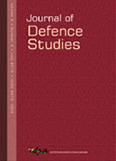Sri Lanka
National Security Decision Making Structures in India: Lessons from the IPKF Involvement in Sri Lanka
A critical appraisal of the national security decision making (NSDM) during IPKF operations is revealing. At every stage, the NSDM was found wanting. The fact that none of the actors possessed the delicate skill or means by which to control events proved that not much thought had gone into the decisions. Involvement of numerous actors made the decision making challenging, which was further complicated by varied and cacophonous inputs and assessments. Overconfidence also created an opaque in the clarity of decisions taken. Lessons from the IPKF involvement are numerous.
- N. Manoharan
- October 2009
Sri Lanka: Dismounting the Tiger
A critical appraisal of the national security decision making (NSDM) during IPKF operations is revealing. At every stage, the NSDM was found wanting. The fact that none of the actors possessed the delicate skill or means by which to control events proved that not much thought had gone into the decisions. Involvement of numerous actors made the decision making challenging, which was further complicated by varied and cacophonous inputs and assessments. Overconfidence also created an opaque in the clarity of decisions taken. Lessons from the IPKF involvement are numerous.
- M.R. Narayan Swamy
- October 2009
Growing Chinese influence in Sri Lanka
Sri Lanka has achieved military victory over Liberation Tigers of Tamil Eelam (LTTE). This fight against the LTTE has had different connotations for both India and China. In the current scenario India had to be neutral as this definitely would have had repercussions on Indian soil. The involvement of Tamil’s had put to test the Indian internal security. And thus the Indian government had to decide not to supply arms and ammunitions to the Sri Lankan government in its fight against the LTTE.
- Gunjan Singh
- June 08, 2009
Brief on India’s Neighbourhood
Terrorism, maritime security and border management are the key challenges in India's neighbourhood
- South Asia cluster
- May 28, 2009
Learning the right lessons on the just concluded counter insurgency operations in Sri Lanka
The death of the Liberation Tigers of Tamil Eeelam (LTTE) leader Prabhakran closes a chapter in the first counter insurgency success of the 21st century by military means. A greater challenge in nation building now faces the Sri Lankan people - integrating the Tamils in their society dominated by Sinhala Buddhists.
Purely from a military point of view some important lessons and some areas of further inquiry emerge. In brief they are:
- P. K. Gautam
- May 22, 2009
Masses in Flight: The Crisis of Internal Displacement in Sri Lanka
The exodus from the conflict zone in Sri Lanka as well as the plight of those still trapped in it have not only become a major focus of international attention, but also raise questions about President Mahinda Rajapaksa’s ‘peace through war strategy’. The Sri Lankan government’s case for the final assault on a weakened LTTE irrespective of the “human catastrophe” needs to be challenged. Neither is there a guarantee that life for the affected population will change for the better once they leave government-controlled areas, indicating that the war could drag on indefinitely.
- M. Mayilvaganan
- May 05, 2009
Will The Fall Of Killinochchi End Ethnic Crisis In Sri Lanka?
After nearly four months of intense conflict, the Sri Lankan military has finally taken control of Killinochchi, a key northern Sri Lankan town and the de facto capital of the Liberation Tigers of Tamil Eelam (LTTE). In fact, in the ongoing fourth Eelam War, Killinochchi is an important milepost, and thus constitutes an outstanding victory for the advancing troops and a big blow to the Tigers. In particular, the capture of the administrative capital of the rebels represents a symbolic victory for the Sri Lankan government, which has been fighting the rebels for over two decades.
- M. Mayilvaganan
- January 12, 2009
Is it Endgame for LTTE?
The LTTE (Liberation Tigers of Tamil Eelam) struggle against the Sri Lankan Government has taken different forms at different times since early 1970s. However, developments since 2006 have had an adverse impact on the LTTE and its efforts to seek a solution through violent means. The LTTE's numerical strength has fallen and it is also not doing too well in drafting recruits and procuring arms. The territory under its control is shrinking visibly: from the loss of the East and now with the intrusion of the Sri Lankan troops deep inside Killinochchi.
- M. Mayilvaganan
- January 2009










